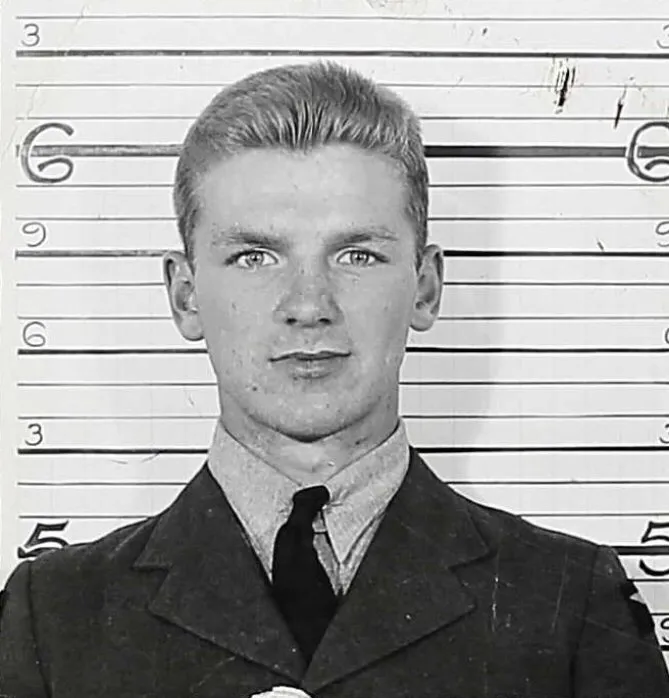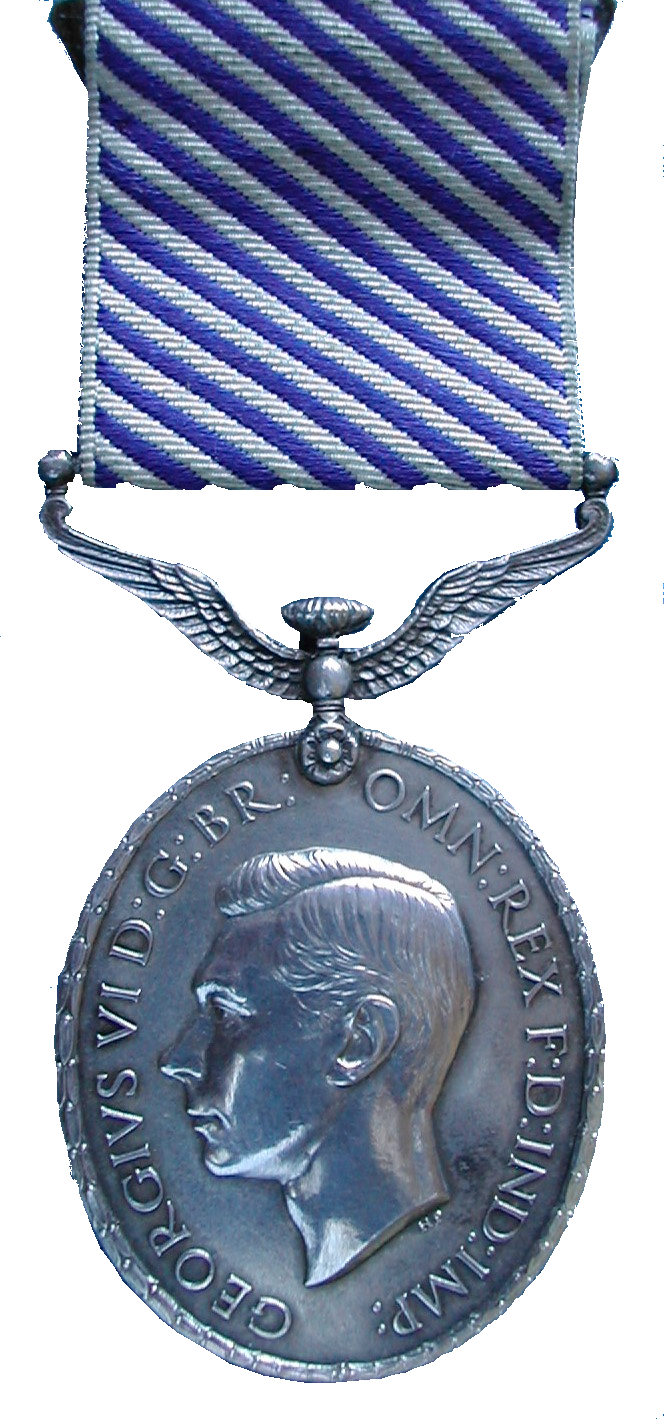Weaver, Claude III (Pilot Officer)
Killed in Action 1944-January-28
Service
RCAF
Unit
403 Sqn- Squadron
Stalk and Strike
Base
Rank
Pilot Officer
Position
Pilot
Service Numbers
J/18784
Home
Spitfire serial: MA642
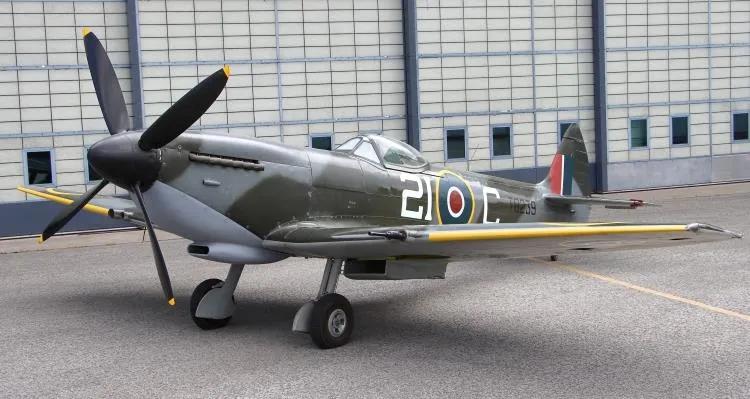
The Supermarine Spitfire is a British single-seat fighter aircraft that was used by the Royal Air Force and other Allied countries before, during, and after World War II. Many variants of the Spitfire were built, using several wing configurations, and it was produced in greater numbers than any other British aircraft. It was also the only British fighter produced continuously throughout the war. The Spitfire continues to be popular among enthusiasts; around 70 remain airworthy, and many more are static exhibits in aviation museums throughout the world.
The Spitfire was designed as a short-range, high-performance interceptor aircraft by R. J. Mitchell, chief designer at Supermarine Aviation Works, which operated as a subsidiary of Vickers-Armstrong from 1928. Mitchell pushed the Spitfire's distinctive elliptical wing with cutting-edge sunken rivets (designed by Beverley Shenstone) to have the thinnest possible cross-section, helping give the aircraft a higher top speed than several contemporary fighters, including the Hawker Hurricane.
The Spitfire had detachable wing tips which were secured by two mounting points at the end of each main wing assembly. When the Spitfire took on a role as a high-altitude fighter (Marks VI and VII and some early Mk VIIIs), the standard wing tips were replaced by extended, "pointed" tips which increased the wingspan from 36 ft 10 in (11.23 m) to 40 ft 2 in (12.24 m). The other wing-tip variation, used by several Spitfire variants, was the "clipped" wing; the standard wing tips were replaced by wooden fairings which reduced the span by 3 ft 6 in (1.07 m). The wing tips used spruce formers for most of the internal structure with a light alloy skin attached using brass screws.
Due to a shortage of Brownings, which had been selected as the new standard rifle calibre machine gun for the RAF in 1934, early Spitfires were fitted with only four guns, with the other four fitted later. Early tests showed that, while the guns worked perfectly on the ground and at low altitudes, they tended to freeze at high altitude, especially the outer wing guns, because the RAF's Brownings had been modified to fire from an open bolt. While this prevented overheating of the cordite used in British ammunition, it allowed cold air to flow through the barrel unhindered. Supermarine did not fix the problem until October 1938, when they added hot air ducts from the rear of the wing-mounted radiators to the guns, and bulkheads around the gunbays to trap the hot air in the wing. Red fabric patches were doped over the gun ports to protect the guns from cold, dirt, and moisture until they were fired.
The first Rolls-Royce Griffon-engined Mk XII flew in August 1942, and first flew operationally with 41 Squadron in April 1943. This mark could nudge 400 mph (640 km/h) in level flight and climb to an altitude of 33,000 ft (10,000 m) in under nine minutes. As American fighters took over the long-range escorting of USAAF daylight bombing raids, the Griffon-engined Spitfires progressively took up the tactical air superiority role, and played a major role in intercepting V-1 flying bombs, while the Merlin-engined variants (mainly the Mk IX and the Packard-engined Mk XVI) were adapted to the fighter-bomber role. Although the later Griffon-engined marks lost some of the favourable handling characteristics of their Merlin-powered predecessors, they could still outmanoeuvre their main German foes and other, later American and British-designed fighters.Wikipedia
![]() Wikipedia Supermarine Spitfire
Wikipedia Supermarine Spitfire
Unit Desciption
403 Sqn Stalk and Strike ("Wolf")
History of the Squadron during World War II (Aircraft: Tomahawk I & IIA, Spitfire IIA, VB, VC, IX, IXB, XVI)
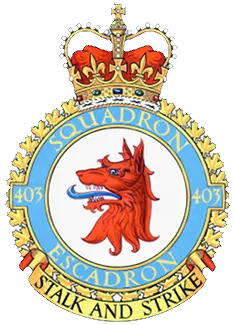
The squadron was formed at Baginton, Warwickshire, UK ![]() in March 1941 and was the first RCAF fighter squadron to be formed overseas in WWII. It was originally intended to be an Army Co-operation squadron, but was rapidly transformed to a fighter squadron as a unit of No 9 Group of RAF Fighter Command. It was originally issued with Curtiss Tomahawk fighters, but these were rapidly replaced by Supermarine Spitfire Mk I, which were in turn replaced by Spitfire Mk V before the squadron became operational with No 11 Group of Fighter Command at Hornchurch, Essex in August 1941.
in March 1941 and was the first RCAF fighter squadron to be formed overseas in WWII. It was originally intended to be an Army Co-operation squadron, but was rapidly transformed to a fighter squadron as a unit of No 9 Group of RAF Fighter Command. It was originally issued with Curtiss Tomahawk fighters, but these were rapidly replaced by Supermarine Spitfire Mk I, which were in turn replaced by Spitfire Mk V before the squadron became operational with No 11 Group of Fighter Command at Hornchurch, Essex in August 1941.
Between then and June 1942 the squadron operated from Hornchurch, Debden, North Weald and Southend (all in Essex). Its operations consisted mainly of fighter sweeps over the English Channel and France, and in CIRCUS operations. In October the squadron was transferred to East Coast convoy patrols from Martlesham Heath, Suffolk, returning to North Weald from December 1941 to May 1942. The squadron then moved to Catterick, Yorks from June 1942 to January 1943 as part of No 13 Group of Fighter Command, although it flew south to Manston, Kent, to take part in the Dieppe invasion debacle on August 19th. It flew 4 operations on that day, shooting down 3 enemy aircraft and damaging 3 more, for the loss of 3 Spitfires. In January 1943 the squadron returned from Catterick to Kenley, Surrey, to join the Canadian Kenley Wing of No 11 Group, which in July became part of the 2nd Tactical Air Force (TAF). The squadron was part of No 127 (RCAF) Wing of No 83 Composite Group. By now the squadron was equipped with Spitfire Mk IX fighters. The operations consisted of fighter sweeps and RHUBARB and RAMROD raids. To prepare the squadron for future operations in Europe, the squadron spent some months at temporary, tented airstrips at Lashenden and Headcorn in Kent, before returning to Kenley in mid-October. Operations continued as before from Kenley until April 1944, when the squadron moved to Tangmere, Sussex, and began to undertake dive-bombing operations. It claimed that it was the first Spitfire Group to commence the bombing of Europe. On D-Day it switched to shipping patrols over the invasion fleets. The squadron moved to France on June 15, 1944 where it provided armed reconnaissance cover for the armies. This activity continued until the New Year, with the squadron moving bases constantly to keep in touch with the advances of the armies. The squadron re-equipped with Spitfire Mk XVI in December 1944, and in 1945 reverted to its dive-bombing function until the end of the war in Europe. The squadron disbanded at Fassberg, Germany ![]() on 10 July 1945.
on 10 July 1945.
In the course of hostilities, the squadron flew about 13,000 sorties and shot down 123 enemy aircraft, 10 probably destroyed and 72 damaged. 70 tons of bombs were dropped, and the squadron was credited with 17 rail cuts and many locomotives, freight cars and automobiles destroyed. The cost was 85 aircraft and 75 pilots of whom 4 were killed and 40 posted missing, presumed dead. The squadron personnel included 4 aces (Flight Lieutenant H.D. MacDonald DFC & Bar, Flight Lieutenant J.D. Lindsay DFC, Squadron Leader L.S. Ford DFC & Bar, Squadron Leader H.C. Godefroy DFC & Bar), and won 16 DFCs, 4 Bars to DFC, 1 MM (for an escape from a PoW camp) and 3 MiDs. Battle Honours were: Defence of Britain 1941-1944, English Channel and North Sea 1942, Fortress Europe 1941-1944, Dieppe, France and Germany 1944-1945: Normandy 1944, Rhine. Kostenuk and Griffin
Maps for Movements of 403 Squadron 1941-45
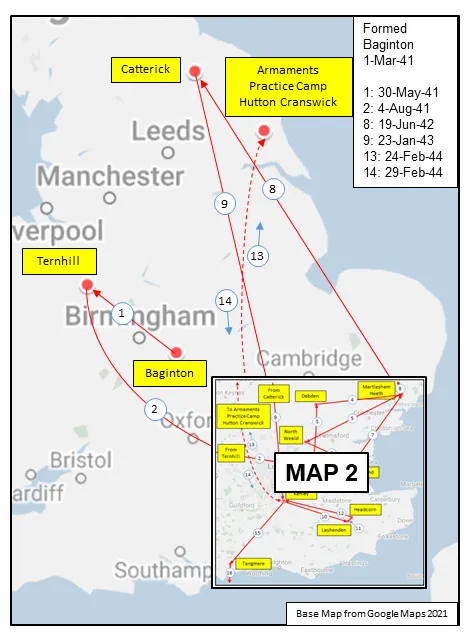
MAP 1: 403 Squadron Movements in Britain 1941-45, (right-click on image to display enlarged in new tab)
|
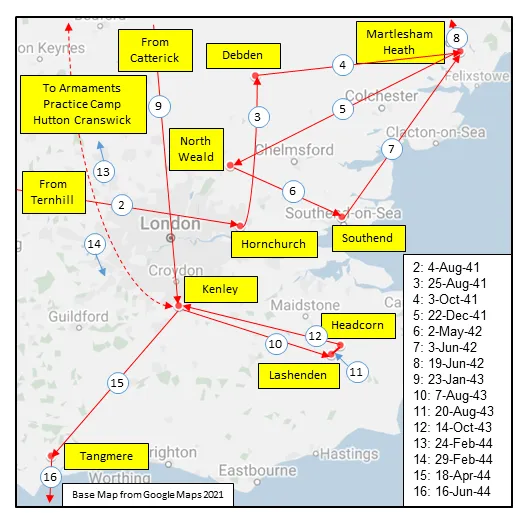
MAP 2: Insert from Map 1
|
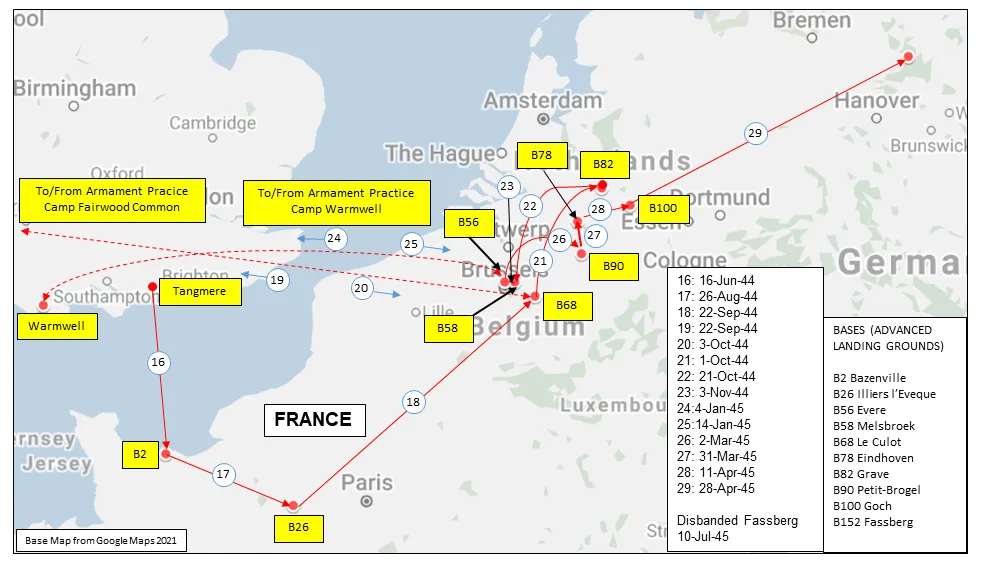
MAP 3: 403 Squadron Movements in Europe 1944-45
|
403 Sqn History Summary 1941-45
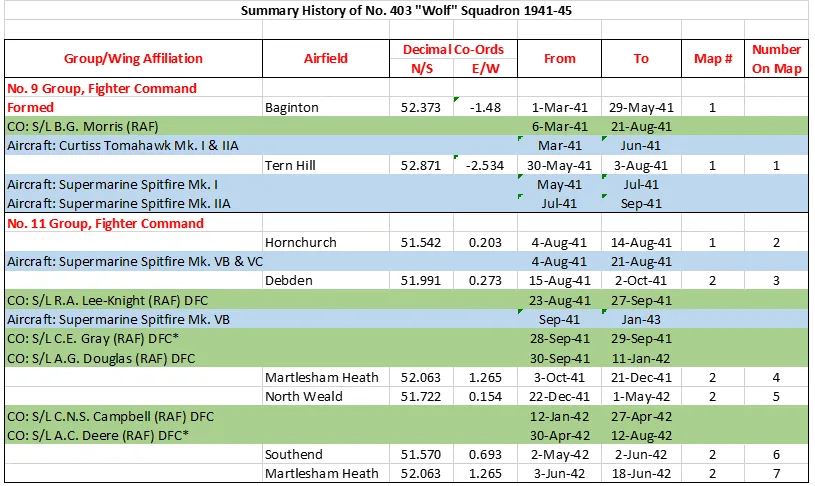
403 Sqn History Summary 1941-45 Page 2
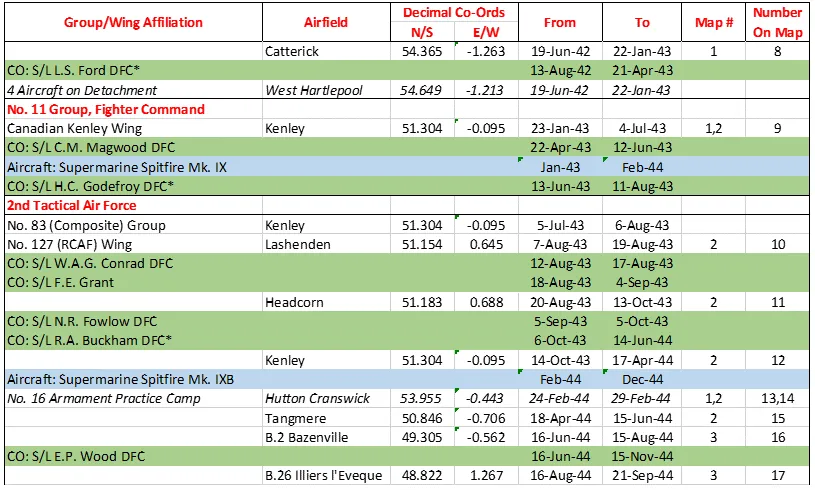
403 Sqn History Summary 1941-45 Page 3
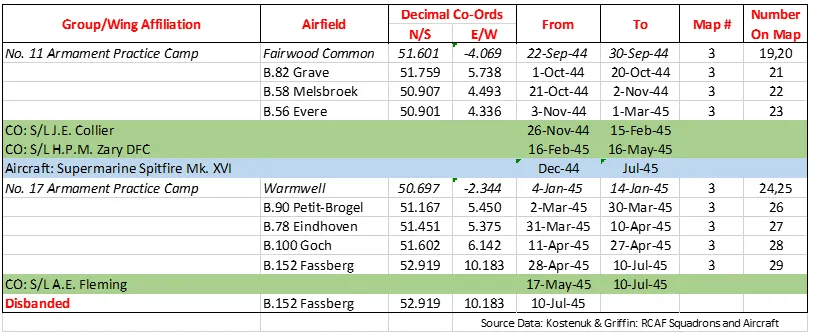
History of the Squadron Post-WWII (Aircraft: Harvard II, Mustang IV, Silver Star, Expeditor, Otter, Twin Huey, Kiowa)
The squadron re-formed as No. 403 (FB) Sqn (Aux), at Calgary, Alberta ![]() on 15 October 1948, flying North American Harvard II aircraft. It was re-titled No. 403 “City of Calgary†(FB) Sqn (Aux) on 3 September 1952. It was re-designated No. 403 “City of Calgary†(F) Sqn (Aux) on 16 November 1953, by which time it was flying North American Mustang IV (P-51-D) aircraft. Again it was re-designated No. 403 “City of Calgary†(T) Sqn (Aux) on 25 January 1957, when it was re-designated a transport unit and re-equipped with Beechcraft Expeditor aircraft. It was again re-designated No. 403 “City of Calgary†Sqn (Aux) on 1 April 1958 in a light transport and emergency rescue role and received de Havilland Otter aircraft. It was disbanded at Calgary on 1 Apr 64.
on 15 October 1948, flying North American Harvard II aircraft. It was re-titled No. 403 “City of Calgary†(FB) Sqn (Aux) on 3 September 1952. It was re-designated No. 403 “City of Calgary†(F) Sqn (Aux) on 16 November 1953, by which time it was flying North American Mustang IV (P-51-D) aircraft. Again it was re-designated No. 403 “City of Calgary†(T) Sqn (Aux) on 25 January 1957, when it was re-designated a transport unit and re-equipped with Beechcraft Expeditor aircraft. It was again re-designated No. 403 “City of Calgary†Sqn (Aux) on 1 April 1958 in a light transport and emergency rescue role and received de Havilland Otter aircraft. It was disbanded at Calgary on 1 Apr 64.
In January 1968, the squadron was re-activated as 403 (Helicopter) Operational Training Squadron (Hel) OTS at Canadian Forces Base (CFB) Petawawa and was equipped with 10 CUH-1H helicopters. It was formed specifically to support the Land Forces. In July 1972, the squadron was given the role of training of aircrew and technical personnel for the Tactical Helicopter and Rescue Squadrons. To carry out its new role, the squadron joined 422 Squadron at CFB Gagetown, New Brunswick ![]() and was equipped with 11 CH-135 Twin Huey and 10 CH-136 Kiowa helicopters. In August 1980, the squadron gained aircrew and support personnel from the disbandment of 422 Squadron. In August 1980, the Air Ground Operations School was formed to provide advance training for future Flight Commanders and Operations Officers. Renamed Aviation Tactics Flight in June 1995, the Flight continues to provide this training, and aviation support to the Combat Training Centre, 1 Wing and the Air Force.
and was equipped with 11 CH-135 Twin Huey and 10 CH-136 Kiowa helicopters. In August 1980, the squadron gained aircrew and support personnel from the disbandment of 422 Squadron. In August 1980, the Air Ground Operations School was formed to provide advance training for future Flight Commanders and Operations Officers. Renamed Aviation Tactics Flight in June 1995, the Flight continues to provide this training, and aviation support to the Combat Training Centre, 1 Wing and the Air Force.
In July 1990, the squadron renewed its post-war relationship with the Air Reserves. At that time the Combat Training Centre (CTC) Gagetown Detachment of the CFB Chatham Air Reserve Augmentation Flight (ARAF) took up residence in the squadron. The flight became an integral part of the Squadron in 1996.Renamed the Air Reserve Section in 1998, the squadron's reservists are incorporated into and provide support to all flights. In August 1992 the Land Aviation Test and Evaluation Flight (LATEF) was formed to conduct, on behalf of 10 Tactical Air Group (10 TAG), operational and tactical testing of land aviation helicopter systems and support equipment, and to propose operational and tactical doctrine where applicable. It quickly evolved into a valuable asset and has been integrally involved in the testing and improvement of CH-146 Griffon systems.
The Kiowa and Twin Huey were phased out of the squadron by the end of 1994 and early 1995 respectively and were replaced by the CH-146 Griffon in March 1995. The squadron became the first operational CH-146 unit in 10 TAG in October 1995.
Supplemental Story
This story Provided by Tom Walsh, American RCAF Warriors
On Friday January 28, 1944 three Supermarine Mk IXc Spitfires from 403 "Wolf" fighter Squadron RCAF provocatively overflew Luftwaffe occupied fighter airfield at Valenciennes, Douai, Vitry and Eminoy. The German personnel at these former French bases watched in awe as the Canadian trio flew a perfect line abreast formation just below the 3,000 foot cloud deck.
Just after 14:45 hrs, 32 year old Oberstleutnant Heinz-Gerhardt Vogt from 7th Satffel./Jagdgeschwader 26 (7./JG 26) scrambled his fighters from Grevillers in an attempt to intercept the enemy raiders. Fighting in western France since 1940, JG 26, flying their yellow nosed Focke-Wulf Fw 190A-6's, were more comply know as "The Abbeville Kids". Knowing his enemy's altitude and direction Vogt's Staffel took off on a north-easterly heading. The German pilot climbed just high enough into the overcast so that they would be able to spot the Canadian aircraft as they flew on a reciprocal course beneath them. However, both flights managed to pass each other sight unseen. Reversing his course, the experience Oberstleutnant located and engaged the Canadian at 15:37 hours just as they were overflying the airfield.
In the ensuing dog fight, two of the spitfires, flown by Flight Lieutenants Thornton and Foster were badly damaged. Using all their flying skills, the pair managed to make good their escape back across the English Channel to RAF air station Kenley. The third aircraft, code MA-642 and flown by the section leader was chased and shot down by Vogt as it raced for the protection of nearby clouds.
Gerhardt Vogt had just scored his 18th kill. He watched his opponent open his canopy and prepare to bail out of his crippled warplane. His victim was a 20 year old American flying in the service of the RCAF. Pilot officer Claude "Weavy" Weaver III was also an ace and had 12.5 aerial victories to his credit. As Weaver exited his fighter, he pulled his ripcord prematurely cause his parachute to billow too close to the falling plane. His body passed safely under the aircraft tail, but some of the inflated parachute panels passed over the top of the tailplane. Vogt watched in horror as the unthinkable happened - several parachute shroud lines caught then became entangled, anchoring the pilot to the fighters tail. Pilot and aircraft fell together as one to the frozen earth below. The violent impact did not immediately end the young American's life! Weaver was rushed by French authorities, barely alive, to a local hospital, but mercifully died three hours later from massive injuries.
Four months earlier, Vogt had shot down another Spitfire ace who had the exact same score as Weaver - 12.5 confirmed. Flight Lieu tenant F.A.O. "Tony" Gaze, an Australian flying with RAF No. 66 squadron, was Vogt's 14th victim. Unlike Weaver, Gaze successfully bailed out, evaded back to England and resumed flying combat. The horrific image of Weaver's last moments stayed with Vogt until he himself was shot down and killed in aerial combat on January 14, 1945. That day, twenty-five P-51D Mustangs from the 78th Fighter Group, United States Army Air Force intercepted him and elements of 5./JG 26 at low level near Cologne, Germany. Heinz-Gerhard Vogt had run his score to 48 victories, was on his 174th combat mission and was flying a long nosed Fw 190D-9 Dora fighter coded "White 13". Right up until the time of his death, Vogt told everyone he knew the unsettling story of Weaver's tragic demise. It bothered him that a "Warrior" had died in that manner.
Claude Weaver the III was born in Oklahoma City, Oklahoma on August 18, 1923. His father, Claude the II, was Oklahoma's Assistant State Attorney General. His grandfather, Claude the I, was a Federal Court Judge who previously had served as a US Congressman. There were two other children in the Weaver family, a younger brother, David and an older sister, Virginia. The family lived in a large two storey house at 1201 Northwest 38th Street and were considered, at the time, to be financially well off.
Claude Weaver dropped out of Classen High School midway through his Grade XI studies so that he could join the RCAF. He was only seventeen years old when he interrupted his formal education to begin his great adventure. Perhaps he was inspired after watching newsreel clips at his local movie theatre of those intrepid RAF Spitfire and Hurricane pilots who had so valiantly defended England during the "Battle of Britain".
Maybe it was British Prime Minister Winston Churchill's stirring speech of August 20, 1940 when he said, "The gratitude of every home in our island, in our empire and indeed throughout the world, except in the abodes of the guilty, goes out to the British airmen who undaunted by odds, unwearied in their constant challenge and mortal danger, are turning the tide of the World War by their prowess and by their devotion. Never in the field of human conflict was so much owed by so many to so few".
Retired US Air Force Captain W. M. "Mac" Palmer from Austin, Texas told the writer in several telephone interviews the true story behind Claude's motivation to join up. He was a close friend of Weavers and went through grade and high school with him in Oklahoma City. Mac says, "Claude was a fantastic athlete who swam, boxed and played tennis. When he was 15, Weaver broke his neck in a diving accident and had to wear an upper body cast for almost a year. He was very smart and could obtain good grades when he applied himself. Claude, however, was constantly in trouble with school officials for acting out or talking too much in class. He was also a school yard bully who was quick to pick a fight, particularly with students from the other city high schools, over matters as trivial as the loss of a high football game. One too many of his after school altercations finally 1anded him in court. He did, however, have the very good fortune to appear before a judge who just happened to be a friend of his grandfather. The judge decided Mr. Weaver needed some discipline in his young life and offered him a choice - join a military service or face a term of incarceration in juvenile reform school".
Claude, who always wanted to be a pilot, had only one option and that was to go to Canada. His parents reluctantly bought him a bus ticket to Detroit, Michigan whereupon he crossed the United States/Canadian border at Windsor, Ontario and enlisted in the RCAF at No. 8 Recruiting Centre on February 13, 1941. The air force assigned him Service No. R/83374 and his rank was as an Aircraftman Second Class Airman. He spent the early part of his RCAF experience at the following two makeshift training facilities as a large influx of applicants had temporarily overwhelmed the system.
February 14 to March 20 - 1A Manning Depot, Picton, Ontario - Claude and others were at this RCAF air station while it was still under construction. It officially opened on April 28, 1941 as No. 31 Bombing and Gunnery School.
March 22 to May 3 - Guard duty at RCAF air station, Sydney, Nova Scotia.
On May 4, Weaver reported to No. 3 Initial Training School in Victoriaville, Quebec. He passed out of this course with a 75% average on June 7 and was promoted to Leading Aircraftman.
The next day he began his flight training on Fleet Finch II biplane trainers at No. 17 Elementary Flying Training School in Stanley, Nova Scotia. Weaver graduated from No. 17 on July 26, 1941 with a 70.6% grade average.
At this point he had 56.6 flying hours recorded in his log book (25.55 dual and 31.05) solo plus 8 hours of link trainer time. In his file from No. 17 was the following notation: "Learns quickly and has above average intelligence, but is inclined to be cocky and a smart aleck". Weaver was posted on July 27 to No. 8 Service Flying Training School at Moncton, New Brunswick.
His dream was to fly fighters so one can only imagine how disappointed he was when he learned that he would finish his training flying twin-engine Avro Ansons. He suddenly realized the RCAF was streaming him to fly multi-engine aircraft, bombers or perhaps even transports. His grades and his attitude plummeted! He crash-landed an Anson off station and the cause of the accident was attributed pilot carelessness. Disciplinary action was taken and, as punishment, he was confined to barracks for seven days.
ln a graduation ceremony on October 10, Weaver was awarded his RCAF pilot wings and was promoted to Sergeant Pilot. However, he had not applied himself to the final stage of his flight training and almost did not make it through. He barely obtained a passing grade and ranked 39th last in his graduating class. On his final assessment his Squadron Commander noted the following: "Discipline Poor. Has too much to say. Is a wise guy". The station's Commanding Officer, Wing Commander W. W. Brown, knowingly or unknowingly steered Weaver happily back into his realm when he recommended fighters were the only type of service aircraft he should fly. The station's Chief Flying Instructor, Squadron Leader Keith Louis Bate Hodson from London, Ontario had the final say as to whether or not Weaver would graduate with his classmates. He tempered his "yes" decision with the following remarks: "Very young. Has a schoolboy complex. But lots of courage".
Keith Hodson stayed in the RCAF after the war and rose to the rank of Air Vice Marshall (AVM). Sixteen years after Weaver's tragic death, Hodson was killed in an eerily similar bail-out accident. On July 5, 1960 AVM Hodson jumped out of a crippled T-33 jet trainer near Colorado Springs, Colorado. His parachute momentarily caught on the plane's tail and, after several agonizing seconds, he managed to free himself. But in his wild struggle to survive, several parachute shroud lines wrapped around his neck. When Hodson reached the ground he was dead from strangulation! At the time, Hodson was Deputy Chief of Staff at North American Aerospace Defence Command Headquarters.
Sergeant Pilot Weaver happily left Moncton with 144.95 flight hours on Ansons recorded in his log book. Taking the standard two week pre-embarkation leave, he returned home to visit with and, in particular, his high school sweetheart, Ramona Yergler. Returning to Canada, Claude left "Y" Depot, Halifax, Nova Scotia on November 2 on a troop ship bound for England. Arriving on 14th he was sent to No. 3 Personnel Reception Centre in Bournemouth on England's south coast. From December 6 to January 5, 1942, he flew Miles Master trainers with an Advanced Flying Unit at RAF air station Cranwell. From February 10, to April 15 Claude flew Miles Masters and Hawker Hurricanes at No. 56 Operational Training Unit, first from Sutton Bridge, Lincolnshire and later from Tealing, Dundee, Scotland.
After graduating, Weaver was posted on April 16 to RCAF No. 412 "Falcon" Fighter Squadron who were flying Spitfire Vb's initially from Wellingore and later from Martlesham Heath in Suffolk. Flight Lieutenant W. Barry Needham of Wynyard, Saskatchewan spent twenty-six months flying combat with 412 completing two tours of operation. "I remember Claude extremely well", Needham recalls. He had led Weaver on a "Rhubarb Mission", a strafing sweep at low level by a few aircraft, to the Ostend, Belgium area on May 21, 1942. He said the weather that day was lousy, low cloud which they flew in and out of while just a few feet above the water. Eventually they were separated and that is when they should have turned around and aborted their mission. However they did not. Barry shot up some barges and a flak position. When Claude returned he reported flying out of the soup into brilliant sunshine right over the middle of Ostend harbour. The Germans put up the most horrendous flak barrage, but missed.
Volunteering to go to Malta, Weaver left 412 at the beginning of June. Along with two dozen other Spitfire replacement pilots, Weaver reached the island on the 29th via the British aircraft carrier HMS Eagle. Claude then joined RAF No. 185 "Malta Squadron" at Qrendi where he flew a mixture of Spitfire Vb's and c's. In his first contact with the enemy on July 17, 1942, Weaver shot down a Messerschmitt Bf 109. Over the next six days, he added four more 109's to his score, a double on the 22nd and another on the 23rd, achieving the coveted title of ace! The squadron's diarist recorded the following; "Shorty Reid with Sergeant Weaver, one of the new boys, each accounted for a 109F type. The boys also escorted the RAF high-speed rescue launch that went out of its way to pick up the downed Jerries". Weaver was successful again five days later as the diarist continued. "Weaver maintained his good work, this time shooting down two nasty Bf 109F's." The following day Weaver saw yet more action. "A flight went to town on a radar plot of 15+, with Sergeant Weaver scoring another double - 2 Bf 109's again a really excellent record.
At the age of 18 Claude Weaver became the youngest allied fighter ace of World War II. Wing Commander Brown's assessment back in New Brunswick of the type of service aircraft Weaver should only fly was absolutely correct!
Before he turned 19, Claude added .5 of a Junkers Ju 88 on July 24 a Bf 109 probable on August 2 and two additional Bf 109 kills on August 17. Days after celebrating his birthday, Weaver claimed another Bf 109 probable on the 25th and two days later he accounted for a Ju 88, a Bf 109 and a Ju 88 probable. His score to that point stood at 9.5 confirmed and 3 probables.
Weaver's string of kills almost ended at 1458 hours on July 31 when he was bested in combat by Oberstleutnant Gerhard Michalski of 4./JG 53 who was flying a Bf 109G-2. After becoming Michalski's 41st victim, Weaver crash-landed Spitfire EP343 on the island.
Gerhard Michalski survived the war flying a total of 652 combat missions. His final aerial tally was 73 victories.
For destroying 5.5 German aircraft in only eight days, Weaver learned on September 4 that he was being awarded a Distinguished Flying Medal (DFM). Part of his published award read as follows.
"This non-commissioned officer has shown great zeal and initiative in combat. Though relatively inexperienced he has, by his dash and personal courage, been an inspiration to the other fighter pilots of his unit".
Flying Spitfire Vc coded 'X BR112 on a fighter sweep to Comiso aerodrome in Sicily on September 9, Weaver shot down an Italian Macchi MC.202 Folgore fighter. To achieve this victory, he had to chase and catch the 352 Squadriglia aircraft in a near vertical dive. Weaver's engine was then shot out by his victim's wingman, Paolo Damiani, who had worked his way unnoticed in behind Claude's aircraft. Claude's element leader suggested that he put his Spitfire down in the shallow surf parallel to the beach at Scoglitti. Weaver replied ,"No thanks", and announced he was landing directly on the beach. He also said, "I'll get a boat and be back". Sergeant Weaver pulled off a beautiful wheels up landing with the result that there was no noticeable damage to his aircraft other than a bent propellor. For a few minutes he eluded his captors in the sand dunes, but was eventually discovered hiding in some tall grass a short distance away.
On September 22, Claude's mother, Retha Dellinger Weaver, received a letter from No. 185's Commanding Officer, Squadron Leader C. F. O. Swales, who stated the following.
"By now you have heard from official sources that your son is missing. I have every reason to believe that he is a Prisoner of War (PoW) as he was seen to make a forced landing in enemy territory. The Italian wireless broadcast that an enemy plane had been forced down and the the pilot, an American, was a PoW in their hands. Your son was a very good pilot and an excellent shot. His loss is very much felt in the squadron as his efforts had most certainly added to "score of enemy planes shot down."
Claude spent the next year as a PoW in Camp P. W. 21 at Chieti, Italy.
Barry Needham returned to Canada late in 1943 on a month's leave before heading back to begin his second tour. During the trip home, he met Flight Lieutenant Dennis "Dogass" Newman from Buffalo New York. Newman, an RCAF Wellington bomber pilot, had been in the same camp as Weaver. He told Barry that when Italy surrendered the Italian camp, guards slowly drifted away. The camp's British Senior Officer (BSO) told everyone to stay put as the allies were on their way. He warned them that if anyone left he would personally see to it that each was court marshalled. Newman, Weaver and several others, including Lieutenant Harold "Mouse" Rideout, a 26 year old P-40 Curtiss-Wright Warhawk pilot from Ashburnham, Massachusetts, said to hell with that and took off. Weaver teamed with Rideout in the bid for freedom. The pair were always packed and ready to go on a moment's notice. They had a good supply of energy bars on hand made from sugar and chocolate they had melted together from their Red Cross packages. Those weekly packages, routed through Switzerland by the boxcar load, literally saved the prisoners' lives. Each week an eleven pound package, plus 100 cigarettes was evenly divided between two men. As neither Weaver nor Rideout smoked, their weekly tobacco allotment greatly enhanced their trading and buying power for other essential items.
It's a good thing they did not listen to the camp BSO as several days later the empty guard towers were staffed by well-armed German paratroopers. Weeks later, P. W. 21 closed. The remaining prisoners were moved several times eventually winding up at Stalag Luft III located near the village of Sagan in southern Poland.
Newspaperman, novelist and Hollywood screen writer, David "Westey" Westheimer, the author of "Von Ryan's Express" and "My Sweet Charlie", knew Weaver while both were interned in P. W. 21. Westheimer, a US Army Air Corps B-24 navigator, was shot down on December 11, 1942 during a bombing raid to Naples harbour. In his 1992 book, "Sitting It Out", David described Claude's life as a PoW.
"A Powerfully built RCAF fighter pilot from Oklahoma City, Weaver, double ace at only nineteen, would stride around the compound, his blonde head arrogantly held high. When our Red Cross parcels arrived, Claude, who was a super trader, would roam the camp like a timber wolf looking for victims. He had no shame! The more lopsided the bargain, the better he liked it. He traded a British Army colonel two tins of British sugar (four ounces) for a tin of English biscuits. Weaver then went off and withIn an hour returned with two bags of Canadian sugar (eight ounces) that he had traded for the biscuits, and he gloated. Weaver was so good at the barter game, he once traded soap, coffee and tea for a guard s rifle!! The BSO made him return it. Claude was wild and reckless and always got into trouble with his captors. On cold sleety nights he would go to the window and call out to the freezing guards walking the wire outside our bungalow, 'Dormi bene Sentinello' "Sleep well, Sentry'. Weaver had the most solitary confinement time of any American in the camp. Late one evening, in one of his many escape attempts, he tangled himself in the wire and was discovered as he tried to break free. The guards knew Weaver by sight and hated him because of his constant taunts. Several proceeded to beat him with their rifle butts. He was saved from certain death when an Italian Red Cross officer stopped them. The officer convinced the guards that Weaver's escape attempt was just a youthful prank. He took Claude aside and told him there had been too many attempts and the camp commandant was pressuring the guards to clamp down. He also told Weaver that if he tried it again, he more than likely would be shot."
The most difficult part of Claude and Harold's journey was that they had to navigate their way through 300 miles of German occupied territory. Rideout, who lives in Hawaii, picks up the story.
"Once outside, we wondered how the Italian farmers would receive us. We both had long handle-bar moustaches, Claude was in his RCAF uniform and I wore khaki. At first many Italians thought we were German. But when they realized we were American, everything was fine. You know they all had a cousin or a friend in New York City. Two days out in a tiny village in hill country, they discovered we were American PoW's. They treated us like kings. They fed us, called the mayor and had a great celebration. They offered us guns which we refused. Two young Italian fellows who wanted to join General Badoglio's army in the south and fight for the allies, offered to act as our guides. We stayed on the mountain trails. The country was beautiful and we enjoyed the warm days and cool September nIghts. We finally decided we had to get out of our uniforms, when we began seeing prints of German hobnail boots on the trail. We discarded our uniforms and obtained some tattered clothing from our guides. Once we came upon a German convoy, so we sat down on a hillside with a shepherd, shared our cigarettes and watched the trucks and tanks roll by. We left our guides behind as they were travelling much slower than we were. We could see our pilots bombing Foggia on the east coast. In one village we entered, the people began callIng to one another up and down the street 'Americanos, Americanos'. The Germans in the village came after us so we took off. We were racing down a steep slope and that's when Claude took a mean fall and injured his ankle. But we kept going for another mile or two. His ankle swelled up like a balloon. Then we came across an armed soldier wearing shorts. We thought he was British as they often wore shorts. When we got closer we saw the swastikas on his uniform. Claude said he'd take him if he had to. We said "Bon Giorno' and walked right past him. He gave us a dirty look and said "Nichts'. Our ragged clothes had fooled him. By this time Claude's ankle was giving him fits. We came upon a deserted farm and I made a bed for him in the hayloft. I set out to find help, some food and discovered a British convoy roaring down a road. I tried to flag them down, but they weren't about to stop for an excited Italian. Finally some sappers directed me to a bridge which was under repair. After I convinced the Canadian Captain in charge of who I was he loaned me a vehicle to bring Weaver in. We got back to the trail to the farm and there was man with a donkey. With the last of the cigarettes and some soap I convinced the man to loan me the donkey for Claude to ride."
Later in a radio interview in London, Weaver completed the rest of the story.
"Rideout put me to bed and said he was going across to the British lines for help. I thought I'd never see him again. But that night, as I hobbled around the farmyard on a crude crutch I had made, I saw a man in an old floppy hat coming up the trail on a donkey. It turned out to be Lieutenant Rideout. He'd found the British lines and came back for me."
Newspapers reported the pair reached allied lines a year to the day after Claude had been imprisoned. Rideout reportedly was leading the donkey with Weaver perched on its back. Claude was wearing a jaunty alpine hat, carrying a shepherd's crook and running a temperature. The two had walked for nine days and nights to reach safety.
RCAF Overseas Headquarters in London, England received a message on October 8, 1943 advising Weaver had arrived safely at Malta. He returned to England on the 18th and was pleased to learn that eight days earlier he had been promoted to Warrant Officer Second Class. The very next day, he was commissioned from the ranks as a Pilot Officer and was assigned a new service number - J/18784. Anxious to return to flying combat, Weaver joined RCAF No. 127 Wing on October 27, initially flying with 421, then 403 squadron.
On November 30, he was invested with his DFM Award at Buckingham Palace where he briefly met KIng George VI during the ceremony.
In his book, "Lucky 13", Wing Commander Hugh Constant "Hughie" Godefroy, recalls meeting Claude Weaver late in 1943. Godefroy was the Commander of RCAF No. 127 Wing.
"I received a rather unusual replacement, Pilot Officer Claude Weaver, DFM. He had been shot down on a.strafing expedition over Sicily while stationed at Malta. He had been Interned in an Italian Pow camp. The Italians treated their prisoners without the slightest respect for the Geneva Convention. Disregarding the fact that it is the duty of a captured combatant to try to escape, the Italians brutally beat Claude after his first two attempts to gain his freedom. At last he escaped and made contact with the advancing allied troops in Italy. Claude was an American who trained in Canada and who wanted to stay in the RCAF after the war. Having heard of the treatment he had endured at the hands of the Italians, I fully expected to meet a very subdued character. When he presented himself at my office, I found myself faced with a tall, blonde, keen-looking fellow who had just turned twenty. He had a neatly trimmed moustache, bright eyes and his uniform, buttons and shoes were in impeccable order. The only sign of past military experience was the DFM ribbon below his wings. It was evident in talking to him that he wanted to get back on operations as quickly as possible. I delegated him to 421 squadron and told him to get checked out on a Spitfire Mk IX and fly around and get familiar with the country. On the day he did his first solo, the wing was grounded by bad weather. Just after tea, I got a phone call from Alex Hamilton, our Wing Engineering Officer.
'Hughie, have we had anybody flying operational today?'
`No, Alex, there's just been the odd fellow doing some local flying. Why?'
`One of the aircraft in 421 squadron came back with the spinner missing from its prop. It's obviously been blown off by a cannon shell. Who is this guy Weaver?'
'He's a new second tour replacement; was he flying the aircraft?'
'He was!'
'Have them send him up to my office immediately.'
Twenty minutes later, Claude Weaver came into my office looking a little sheepish.
"Weaver, I told you to go out and do some local flying,Where did you go?'
"it didn't take me long to get familiar with the area, sir, so seeing that I was up,I went over to France and did a little strafing.'
'If that's the kind of thing you're going to do, Weaver, you might as well pack up your bags and go back to Air Force Headquarters.'
For a moment, I thought he was going to cry. He pleaded with me to let him stay.
"0kay, Weaver, I'll give you one more chance. From now on I will decide if, and when, you will venture over enemy territory. Do you understand?'
'Yes, sir, I promise - I promise!'
This was not the last time I would have to deal with Claude Weaver. Inwardly I was delighted with his keenness and with his reaction to the threat of being turfed, I was sure that he wouldn't play that trick again."
In December, Claude was asked in a radio interview why had he not transferred from the RCAF to the United States Army Air Forces. He replied, "Well, it would take me a few months to train on the Republic P-47 Thunderbolt. Anyway, when the invasion comes I want to be flying a Spitfire".
On December 30, Weaver was flying in a four plane section which was being led by Canada's top scoring fighter ace Flight Lieutenant George "Buzz" Beurling. The other two pilots were Flying Officers Hart Finlay and William Bliss. Southeast of Paris, the four came upon an American heavy bomber group which was being harassed by a mixed force of 109's and 190's. Breaking up the German fighter attack, Beurling and Bliss each destroyed an Fw 190 while Weaver and Findlay each downed a Bf 109.
Claude's last victory, which brought his tally to 12.5, occurred on January 21, 1944 when he shot down an Fw 190 west of Lens.
The last written entry in Weaver's RCAF records, which are held in The National Archives in Ottawa, Ontario simply states "January 28, 1944 - Missing from 403 Squadron - Presumed dead"!
The squadron's diarist made the following entry that fateful day; "The weather today was unfit for a sweep. Readiness was done by the squadron. In the afternoon a ranger sortie was organized by Claude Weaver. The section then flew to RAF Manston to board additional fuel. Only three of the four aircraft got airborne from there. When they got in around Doucie they were bounced by 12+ Fw 190,s. They were all hit. Unfortunately, Claude Weaver has not returned. This is a great shame as we shall miss his exceptional eyesight and the very fine spirit which he displayed at all times. We all sincerely hope that he will be back in a month or so.
403's Officer Commanding in a report to Headquarters described it this way; "Three aircraft of this squadron took off from Manston on this operation and swept Lille/Amiens. They entered the Frenon coast at Nieuport and swept the Lille area and then turned west toward Amiens, the section was flying line abreast at 3,000 feet and below the cloud layer. All aircraft were heavily engaged, Flight Lieutenant Thornton and Flying Officer Foster's aircraft were both hit. When last seen Pilot Officer Weaver was breaking up into cloud with two enemy aircraft on his tail. Sample 42 (the fourth aircraft - author) did not take off from Manston due to engine trouble".
On March 2, 1944, the Oklahoma City native who proved he could fly and fight with the best either side had to offer, was posthumously awarded a British Distinguished Flying Cross (DFC) His medal was presented on May 5, 1945 to his next of kin. The citation read as follows.
"Within recent months this officer had taken part in numerous low level attacks against a variety of targets, such as airfield and gun emplacements and throughout has displayed great determination in air fighting. He has destroyed a further seven enemy aircraft bringing his victories to twelve. His successes are an excellent tribute to his great skill, courage and resolution."
On June 8, 1944, Claude Weaver was Mentioned in Dispatches (MiD). However, there was no citation recorded for this award.
A second tragedy befell the Weaver family on March 5, 1945, when Claude's brother, David, was killed in action on the island of lwo Jima while serving with the United States Marine Corps.
The youngest allied ace of World War II peacefully rests far from Oklahoma in Grave No. 9 in the Meharicourt Communal Cemetery in Somme, France. The Commonwealth War Graves Commission meticulously maintains the graves of forty other allied airmen at Meharicourt - 21 British, 12 Canadian, 6 Australian and 2 New Zealanders.
Claude Weaver is counted as a Canadian. 1n this quiet country setting, these forty-one decorated airmen are grouped together in one section of the cemetery known as the British Plot, They are great company for each other.
in 1994, Barry Needham visited several Commonwealth War Grave Cemeteries in France while attending 50th Anniversary D-Day celebrations. He accidentally stumbled upon Claude's grave at Meharicourt and was shocked when he saw that he was only 20 years old when he died! He could hardly believe that fact. Needham knew Weaver was young, he just never realized how young. The subject of age never came up in their conversations. Barry wonders how was it possible that Claude could join up and go through pilot training at the age of 17? He said, Regardless, he was a hell of a pilot".
Mac Palmer purchased two copies of David Westheimer's PoW memoir "Sitting It Out" and sent one to Weaver's sister. Westheimer graciously signed her copy with the following personal inscription. "For Virginia Weaver Higbee, in memory of your brave brother Claude, from his barracks mate, friend and admirer."
Error: waever.jpg storedperimage per DIR000037 image not foundThe author gratefully thanks the following who provided information for this article: Library & Archives Canada, W.M. Palmer, W. Barry Needham, David Westheimer, Harold Rideout, Hugh Godefroy, The JG 26 War Diaries/Donald Caldwell and M. Hutchison and Jay Marks of the Oklahoman Newspaper.
